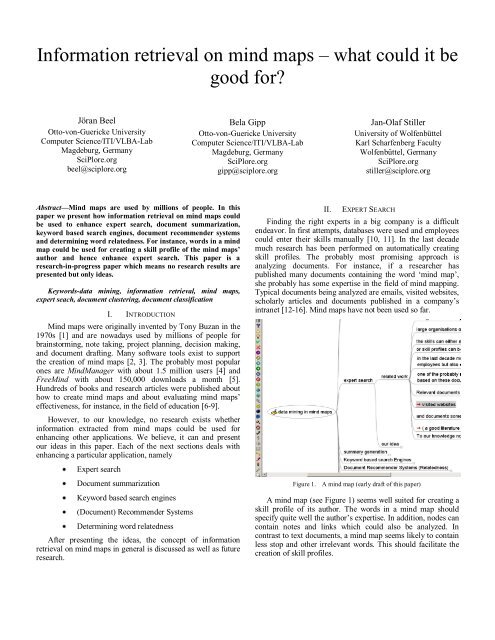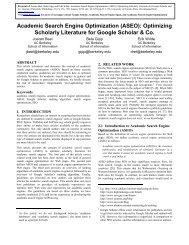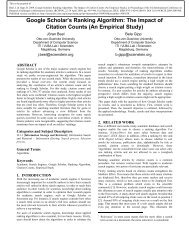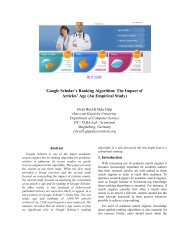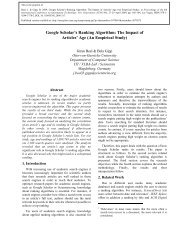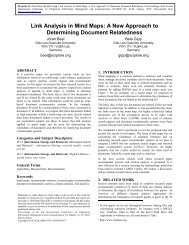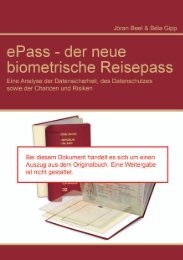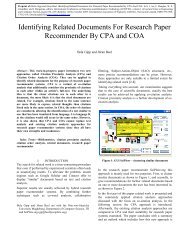Information retrieval on mind maps â what could it be ... - Jöran Beel
Information retrieval on mind maps â what could it be ... - Jöran Beel
Information retrieval on mind maps â what could it be ... - Jöran Beel
Create successful ePaper yourself
Turn your PDF publications into a flip-book with our unique Google optimized e-Paper software.
<str<strong>on</strong>g>Informati<strong>on</strong></str<strong>on</strong>g> <str<strong>on</strong>g>retrieval</str<strong>on</strong>g> <strong>on</strong> <strong>mind</strong> <strong>maps</strong> – <strong>what</strong> <strong>could</strong> <strong>it</strong> <strong>be</strong>good for?Jöran <strong>Beel</strong>Otto-v<strong>on</strong>-Guericke Univers<strong>it</strong>yComputer Science/ITI/VLBA-LabMagdeburg, GermanySciPlore.org<strong>be</strong>el@sciplore.orgBela GippOtto-v<strong>on</strong>-Guericke Univers<strong>it</strong>yComputer Science/ITI/VLBA-LabMagdeburg, GermanySciPlore.orggipp@sciplore.orgJan-Olaf StillerUnivers<strong>it</strong>y of WolfenbüttelKarl Scharfen<strong>be</strong>rg FacultyWolfenbüttel, GermanySciPlore.orgstiller@sciplore.orgAbstract—Mind <strong>maps</strong> are used by milli<strong>on</strong>s of people. In thispaper we present how informati<strong>on</strong> <str<strong>on</strong>g>retrieval</str<strong>on</strong>g> <strong>on</strong> <strong>mind</strong> <strong>maps</strong> <strong>could</strong><strong>be</strong> used to enhance expert search, document summarizati<strong>on</strong>,keyword based search engines, document recommender systemsand determining word relatedness. For instance, words in a <strong>mind</strong>map <strong>could</strong> <strong>be</strong> used for creating a skill profile of the <strong>mind</strong> <strong>maps</strong>’author and hence enhance expert search. This paper is aresearch-in-progress paper which means no research results arepresented but <strong>on</strong>ly ideas.Keywords-data mining, informati<strong>on</strong> <str<strong>on</strong>g>retrieval</str<strong>on</strong>g>, <strong>mind</strong> <strong>maps</strong>,expert seach, document clustering, document classificati<strong>on</strong>I. INTRODUCTIONMind <strong>maps</strong> were originally invented by T<strong>on</strong>y Buzan in the1970s [1] and are nowadays used by milli<strong>on</strong>s of people forbrainstorming, note taking, project planning, decisi<strong>on</strong> making,and document drafting. Many software tools exist to supportthe creati<strong>on</strong> of <strong>mind</strong> <strong>maps</strong> [2, 3]. The probably most popular<strong>on</strong>es are MindManager w<strong>it</strong>h about 1.5 milli<strong>on</strong> users [4] andFreeMind w<strong>it</strong>h about 150,000 downloads a m<strong>on</strong>th [5].Hundreds of books and research articles were published abouthow to create <strong>mind</strong> <strong>maps</strong> and about evaluating <strong>mind</strong> <strong>maps</strong>’effectiveness, for instance, in the field of educati<strong>on</strong> [6-9].However, to our knowledge, no research exists whetherinformati<strong>on</strong> extracted from <strong>mind</strong> <strong>maps</strong> <strong>could</strong> <strong>be</strong> used forenhancing other applicati<strong>on</strong>s. We <strong>be</strong>lieve, <strong>it</strong> can and presentour ideas in this paper. Each of the next secti<strong>on</strong>s deals w<strong>it</strong>henhancing a particular applicati<strong>on</strong>, namelyExpert searchDocument summarizati<strong>on</strong>Keyword based search engines(Document) Recommender SystemsDetermining word relatednessAfter presenting the ideas, the c<strong>on</strong>cept of informati<strong>on</strong><str<strong>on</strong>g>retrieval</str<strong>on</strong>g> <strong>on</strong> <strong>mind</strong> <strong>maps</strong> in general is discussed as well as futureresearch.II.EXPERT SEARCHFinding the right experts in a big company is a difficultendeavor. In first attempts, databases were used and employees<strong>could</strong> enter their skills manually [10, 11]. In the last decademuch research has <strong>be</strong>en performed <strong>on</strong> automatically creatingskill profiles. The probably most promising approach isanalyzing documents. For instance, if a researcher haspublished many documents c<strong>on</strong>taining the word ‘<strong>mind</strong> map’,she probably has some expertise in the field of <strong>mind</strong> mapping.Typical documents <strong>be</strong>ing analyzed are emails, vis<strong>it</strong>ed webs<strong>it</strong>es,scholarly articles and documents published in a company’sintranet [12-16]. Mind <strong>maps</strong> have not <strong>be</strong>en used so far.Figure 1. A <strong>mind</strong> map (early draft of this paper)A <strong>mind</strong> map (see Figure 1) seems well su<strong>it</strong>ed for creating askill profile of <strong>it</strong>s author. The words in a <strong>mind</strong> map shouldspecify qu<strong>it</strong>e well the author’s expertise. In add<strong>it</strong>i<strong>on</strong>, nodes canc<strong>on</strong>tain notes and links which <strong>could</strong> also <strong>be</strong> analyzed. Inc<strong>on</strong>trast to text documents, a <strong>mind</strong> map seems likely to c<strong>on</strong>tainless stop and other irrelevant words. This should facil<strong>it</strong>ate thecreati<strong>on</strong> of skill profiles.
III.DOCUMENT SUMMARIZATIONSearch engines usually display summarized data for eachsearch result. This <strong>could</strong> <strong>be</strong> the document’s t<strong>it</strong>le, URL, or ashort extract of the document’s text. Academic search enginesadd<strong>it</strong>i<strong>on</strong>ally display data such as the author, publishing date orthe abstract (see Figure 2). This does not always deliversatisfying results. In Figure 2, for instance, the extract is notvery informative, <strong>it</strong> equals basically the t<strong>it</strong>le. Alternatively totext extracts, some researchers attempted to automaticallycreate abstracts [17-19] or summarizing documents based <strong>on</strong>user generated data such as hyperlinks [20], social annotati<strong>on</strong>s[21] and annotated bibliographies [22].Figure 2. Example of summary data <strong>on</strong> Google ScholarMind <strong>maps</strong> <strong>could</strong> <strong>be</strong> used to complement summarizati<strong>on</strong> ofdocuments. Most <strong>mind</strong> mapping tools allow to link nodes in the<strong>mind</strong> map w<strong>it</strong>h documents <strong>on</strong> the user’s hard drive or to link anode to a webpage. The node’s text, and the text of parentnodes, <strong>could</strong> <strong>be</strong> seen as a summary for the linked document.Figure 3 illustrates this approach: The node w<strong>it</strong>h the red arrowand gray background links to the PDF file of the scholarlyarticle ‘Are your c<strong>it</strong>ati<strong>on</strong>s clean?’ [23]. This article deals w<strong>it</strong>hproblems of c<strong>it</strong>ati<strong>on</strong> analysis. In this example the node which islinking to the PDF and <strong>it</strong>s parent nodes summarize the article’sc<strong>on</strong>tent well:C<strong>it</strong>ati<strong>on</strong> Analysis -> Problems -> Technical Problems –>problem: different authors w<strong>it</strong>h the same nameCertainly, <strong>on</strong>e occurrence in a <strong>mind</strong> map would not <strong>be</strong>sufficient for a thoroughly summary. But if several users wouldlink a document in several <strong>mind</strong> <strong>maps</strong>, this <strong>could</strong> add up to adescent summary, highlighting <strong>what</strong> readers found mostrelevant in the document.<strong>be</strong> found for a keyword search even if document A does notc<strong>on</strong>tain the keyword, but document B, which is linking todocument A. Usually this kind of link analysis is applied toscholarly l<strong>it</strong>erature and webs<strong>it</strong>es. However, <strong>it</strong> seems likely thatthe same c<strong>on</strong>cept <strong>could</strong> <strong>be</strong> applied to <strong>mind</strong> <strong>maps</strong>.Figure 4. Enhance keyword based search enginesIf a <strong>mind</strong> map links to a document, the words of the linking(and parental) node <strong>could</strong> <strong>be</strong> assigned to the linked document.Figure 4 illustrates this: The <strong>mind</strong> map c<strong>on</strong>tains a node called‘expert search’ and child nodes link to documents related toexpert search (those w<strong>it</strong>h the red arrows). However, many ofthese documents do not c<strong>on</strong>tain the term ‘expert search’, butother expressi<strong>on</strong>s such as ‘expert finder’, ‘expertisemanagement’ or ‘skill management’. If search engines wouldanalyze <strong>mind</strong> <strong>maps</strong> and treat them as ‘neighbored’ documents,recall in document <str<strong>on</strong>g>retrieval</str<strong>on</strong>g> <strong>could</strong> <strong>be</strong> increased.V. (DOCUMENT) RECOMMENDER SYSTEMSOne comm<strong>on</strong> recommendati<strong>on</strong> approach is to recommendthose <strong>it</strong>ems which are related to <strong>it</strong>ems a user likes (<strong>it</strong>em basedrecommendati<strong>on</strong>s). For scholarly l<strong>it</strong>erature and webs<strong>it</strong>es,relatedness often is determined via c<strong>it</strong>ati<strong>on</strong> analysis andhyperlink analysis respectively. The same c<strong>on</strong>cept <strong>could</strong> <strong>be</strong>applied to <strong>mind</strong> <strong>maps</strong>.Secti<strong>on</strong> 1Secti<strong>on</strong> 2Node (No Link)Link 1Link 2Node (No Link)Node (No Link)High RelatednessTopicSecti<strong>on</strong> ...Link 3.........Low RelatednessNode (NoLink)Node (No Link)Secti<strong>on</strong> iNode (No Link)Link 4Figure 5. Expected Link Relatedness (Illustrati<strong>on</strong>)Figure 3. Mind <strong>maps</strong> as document summary and for determining wordrelatednessIV.KEYWORD BASED SEARCH ENGINESWhen searching for documents, usually a keyword isentered and the search engine returns those documentsc<strong>on</strong>taining the keyword. Various algor<strong>it</strong>hms exist to calculatehow relevant a document is for a certain keyword search (e.g.tf-idf and BM25(f)), but usually <strong>on</strong>ly words c<strong>on</strong>tained in thedocuments are c<strong>on</strong>sidered. Only few approaches c<strong>on</strong>siderwords of ‘neighbored’ documents add<strong>it</strong>i<strong>on</strong>ally [24].C<strong>on</strong>sidering neighbored documents means, document A <strong>could</strong>The basic idea of <strong>what</strong> we call ‘Mind Map C<strong>it</strong>ati<strong>on</strong>Analysis’: when two documents A and B are linked by a <strong>mind</strong>map, document B <strong>could</strong> <strong>be</strong> recommended to those users likingdocument A. This c<strong>on</strong>cept <strong>could</strong> <strong>be</strong> enhanced w<strong>it</strong>h comm<strong>on</strong>c<strong>it</strong>ati<strong>on</strong> analysis approaches. For instance, if two documents arelinked in high proxim<strong>it</strong>y, their relatedness can <strong>be</strong> expected to<strong>be</strong> higher than two documents linked in lower proxim<strong>it</strong>y [25,26]. Figure 5 illustrates this c<strong>on</strong>cept: Link 1 and 2 are in directproxim<strong>it</strong>y. Therefore, the linked documents can <strong>be</strong> expected to<strong>be</strong> highly related. Between link 3 and 4 is a higher distance, sotheir relatedness is likely to <strong>be</strong> lower.
VI.DETERMINING WORD RELATEDNESSKnowing how words are related is important for manyapplicati<strong>on</strong>s. For instance, search engines want to determinesyn<strong>on</strong>yms [27-29] and offer search query recommendati<strong>on</strong>s[30-32]; social tagging systems often recommend related tagsto their users [33-35]; and, am<strong>on</strong>g others, for web 2.0applicati<strong>on</strong>s, (semi) automatic generati<strong>on</strong> of <strong>on</strong>tologies isdesirable [36-38]. Again, <strong>it</strong> seems likely that informati<strong>on</strong><str<strong>on</strong>g>retrieval</str<strong>on</strong>g> <strong>on</strong> <strong>mind</strong> <strong>maps</strong> <strong>could</strong> help enhancing theseapplicati<strong>on</strong>s.A <strong>mind</strong> map is a graph and nodes are in hierarchical order.As such the nodes’ terms are in direct relati<strong>on</strong> to each other.For instance, in Figure 3: Based <strong>on</strong> the <strong>mind</strong> map a searchquery recommender <strong>could</strong> recommend the terms ‘problems’ or‘defin<strong>it</strong>i<strong>on</strong>’ to some<strong>on</strong>e searching for ‘c<strong>it</strong>ati<strong>on</strong> analysis’ inorder to specify his search. Or, if a pers<strong>on</strong> is searching for‘c<strong>it</strong>ati<strong>on</strong> analysis’, then ‘peer review’ might <strong>be</strong> an interestingsearch term to broaden the search.VII. DISCUSSION AND FURTHER RESEARCHIn this paper we presented how data of <strong>mind</strong> <strong>maps</strong> <strong>could</strong> <strong>be</strong>used to enhance expert search, document summarizati<strong>on</strong>,keyword based search engines, document recommendersystems and determining word relatedness. The presented ideasare not yet supported by research and <strong>it</strong> <strong>could</strong> turn out that dataof <strong>mind</strong> <strong>maps</strong> is not able to enhance the menti<strong>on</strong>edapplicati<strong>on</strong>s. In add<strong>it</strong>i<strong>on</strong>, two more challenges exist. First, <strong>it</strong> isunknown if a sufficient num<strong>be</strong>r of people create <strong>mind</strong> <strong>maps</strong>and if they are willing to share their data. Sec<strong>on</strong>d, therobustness of data seems cr<strong>it</strong>ical. All platforms analyzing dataof users do have to cope w<strong>it</strong>h spam and fraud as so<strong>on</strong> as they<strong>be</strong>come successful. There is no reas<strong>on</strong> to assume that thiswould <strong>be</strong> different if informati<strong>on</strong> <str<strong>on</strong>g>retrieval</str<strong>on</strong>g> <strong>on</strong> <strong>mind</strong> <strong>maps</strong><strong>be</strong>came successful.As part of the SciPlore.org project we will further researchinformati<strong>on</strong> <str<strong>on</strong>g>retrieval</str<strong>on</strong>g> <strong>on</strong> <strong>mind</strong> <strong>maps</strong>. Recently we developed aspecial <strong>mind</strong> mapping software focusing <strong>on</strong> researchers needs[39]. This software will help to gather and analyze <strong>mind</strong> <strong>maps</strong>in order to see if the here presented ideas may <strong>be</strong> realized.REFERENCES[1] T<strong>on</strong>i Buzan. Making the Most of your Mind. Pan Books, 1977.[2] Open Directory Project DMOZ. Open Directory - Reference: KnowledgeManagement: Knowledge Creati<strong>on</strong>: Mind Mapping: Software. Webs<strong>it</strong>e, Juli2009. URLhttp://www.dmoz.org/Reference/Knowledge_Management/Knowledge_Creati<strong>on</strong>/Mind_Mapping/Software//.[3] Mind-Mapping.org. Software for <strong>mind</strong>mapping and informati<strong>on</strong>organisati<strong>on</strong>. Webs<strong>it</strong>e, Juli 2009. URL http://www.<strong>mind</strong>-mapping.org/<strong>mind</strong>mappingsoftware/35?selectedCategories[]=<strong>mind</strong>%20<strong>maps</strong>&selectedOSes[]=all%20operating%20systems&pastOrPresent[]=current&datePicker2=&filterData=Show+selected+<strong>it</strong>ems.[4] MindJet. MindJet: About MindJet. Webs<strong>it</strong>e, Juli 2009. URLhttp://www.<strong>mind</strong>jet.com/about/.[5] SourceForge. SourceForge.net: Project Statistics for FreeMind. Webs<strong>it</strong>e,2008. URLhttp://sourceforge.net/project/stats/detail.php?group_id=7118&ugn=free<strong>mind</strong>&type=prdownload&mode=year&year=2008&package_ihttp://sourceforge.net/project/stats/detail.php?group_id=7118&ugn=free<strong>mind</strong>&type=prdownload&mode=year&year=2008&package_id=0.[6] Sanford B. Frumker. Mind Map: Your Guide to Prosper<strong>it</strong>y andFulfillment. Health Associates, 1993.[7] Anth<strong>on</strong>y J. Mento, Patrick Martinelli, and Raym<strong>on</strong>d M. J<strong>on</strong>es. MindMapping in Executive Educati<strong>on</strong>: Applicati<strong>on</strong>s and Outcomes. The Journal ofManagement Development, 4(4), 1999.[8] Claire A. Michelini. Mind Map: A New Way to Teach Patients and Staff.Home Healthcare Nurse, 18(5):318–322, 2000.[9] Steve Morris and Jane Sm<strong>it</strong>h. Understanding <strong>mind</strong> <strong>maps</strong> in a week.Hodder & Stought<strong>on</strong>, 1998.[10] T.H. Davenport and L. Prusak. Working knowledge: How organizati<strong>on</strong>smanage <strong>what</strong> they know. Ubiqu<strong>it</strong>y, 1(24), 2000.[11] ME Mar<strong>on</strong>, S. Curry, and P. Thomps<strong>on</strong>. An inductive search system:Theory, design, and implementati<strong>on</strong>. IEEE Transacti<strong>on</strong>s <strong>on</strong> Systems, Man andCy<strong>be</strong>rnetics, 16(1):21–28, 1986.[12] C.S. Camp<strong>be</strong>ll, P.P. Maglio, A. Cozzi, and B. Dom. Expertiseidentificati<strong>on</strong> using email communicati<strong>on</strong>s. In Proceedings of the twelfthinternati<strong>on</strong>al c<strong>on</strong>ference <strong>on</strong> <str<strong>on</strong>g>Informati<strong>on</strong></str<strong>on</strong>g> and knowledge management, pages528–531. ACM New York, NY, USA, 2003.[13] N. Craswell, D. Hawking, A.M. Vercoustre, and P. Wilkins. P@nopticexpert: Searching for experts not just for documents. In Ausweb PosterProceedings, Queensland, Australia, 2001.[14] B. Dom, I. Eir<strong>on</strong>, A. Cozzi, and Y. Zhang. Graph-based rankingalgor<strong>it</strong>hms for e-mail expertise analysis. In Proceedings of the 8th ACMSIGMOD workshop <strong>on</strong> Research issues in data mining and knowledgediscovery, pages 42–48. ACM New York, NY, USA, 2003.[15] M. Maybury, R. D'Amore, and D. House. Expert finding for collaborativevirtual envir<strong>on</strong>ments. 2001.[16] J. Wang, Z. Chen, L. Tao, W.Y. Ma, and L. Wenyin. Ranking user'srelevance to a topic through link analysis <strong>on</strong> web logs. In Proceedings of the4th internati<strong>on</strong>al workshop <strong>on</strong> Web informati<strong>on</strong> and data management, pages49–54. ACM New York, NY, USA, 2002.[17] HP Luhn. The automatic creati<strong>on</strong> of l<strong>it</strong>erature abstracts. Advances inAutomatic Text Summarizati<strong>on</strong>. MIT Press, Cambridge, MA, pages 58–63,1956.[18] CD Paice. The automatic generati<strong>on</strong> of l<strong>it</strong>erature abstracts: an approachbased <strong>on</strong> the identificati<strong>on</strong> of self-indicating phrases. In Proceedings of the3rd annual ACM c<strong>on</strong>ference <strong>on</strong> Research and development in informati<strong>on</strong><str<strong>on</strong>g>retrieval</str<strong>on</strong>g>, pages 172–191. Butterworth & Co. Kent, UK, UK, 1980.[19] CD Paice. C<strong>on</strong>structing l<strong>it</strong>erature abstracts by computer: techniques andprospects. <str<strong>on</strong>g>Informati<strong>on</strong></str<strong>on</strong>g> Processing and Management: an Internati<strong>on</strong>alJournal, 26(1):171–186, 1990.[20] J.Y. Delort, B. Bouch<strong>on</strong>-Meunier, and M. Rifqi. Enhanced web documentsummarizati<strong>on</strong> using hyperlinks. In Proceedings of the fourteenth ACMc<strong>on</strong>ference <strong>on</strong> Hypertext and hypermedia, pages 208–215. ACM New York,NY, USA, 2003.[21] H. Zhang, Z.C.W. Ma, and Q. Cai. A study for documents summarizati<strong>on</strong>based <strong>on</strong> pers<strong>on</strong>al annotati<strong>on</strong>. In Proceedings of the HLT-NAACL 03 <strong>on</strong> Textsummarizati<strong>on</strong> workshop-Volume 5, pages 41–48. Associati<strong>on</strong> forComputati<strong>on</strong>al Linguistics Morristown, NJ, USA, 2003.[22] M.Y. Kan, J.L. Klavans, and K.R. McKeown. Using the annotatedbibliography as a resource for indicative summarizati<strong>on</strong>. Arxiv preprintcs/0206007, 2002.[23] D. Lee, K. Jaewoo, M. Prasenj<strong>it</strong>, L. Giles, and O. Byung-W<strong>on</strong>. Are yourc<strong>it</strong>ati<strong>on</strong>s clean? Communicati<strong>on</strong>s of the ACM, 50:33–38, 2007.[24] X. Qi and B.D. Davis<strong>on</strong>. Classifiers w<strong>it</strong>hout borders: incorporatingfielded text from neighboring web pages. In Proceedings of the 31st annualinternati<strong>on</strong>al ACM SIGIR c<strong>on</strong>ference <strong>on</strong> Research and development ininformati<strong>on</strong> <str<strong>on</strong>g>retrieval</str<strong>on</strong>g>, pages 643–650. ACM New York, NY, USA, 2008.[25] Bela Gipp, Jöran <strong>Beel</strong>, and Christian Hentschel. Scienstein: A ResearchPaper Recommender System. In Internati<strong>on</strong>al C<strong>on</strong>ference <strong>on</strong> EmergingTrends in Computing (ICETiC'09), pages 309–315. IEEE, January 2009.Available <strong>on</strong> http://www.sciplore.org.[26] Bela Gipp and Jöran <strong>Beel</strong>. C<strong>it</strong>ati<strong>on</strong> Proxim<strong>it</strong>y Analysis (CPA) - A newapproach for identifying related work based <strong>on</strong> Co-C<strong>it</strong>ati<strong>on</strong> Analysis. InProceedings of the 12th Internati<strong>on</strong>al C<strong>on</strong>ference <strong>on</strong> Scientometrics andInformetrics (ISSI'09), pages 571–575. Internati<strong>on</strong>al Society forScientometrics and Informetrics, July 2009. Available <strong>on</strong>http://www.sciplore.org.[27] V.D. Bl<strong>on</strong>del, A. Gajardo, M. Heymans, P. Senellart, and P. Van Dooren.A measure of similar<strong>it</strong>y <strong>be</strong>tween graph vertices: Applicati<strong>on</strong>s to syn<strong>on</strong>ymextracti<strong>on</strong> and web searching. Siam Review, 46(4):647–666, 2004.
[28] M. Clements, A.P. de Vries, and M.J.T. Reinders. Detecting syn<strong>on</strong>yms insocial tagging systems to improve c<strong>on</strong>tent <str<strong>on</strong>g>retrieval</str<strong>on</strong>g>. In Proceedings of the 31stannual internati<strong>on</strong>al ACM SIGIR c<strong>on</strong>ference <strong>on</strong> Research and development ininformati<strong>on</strong> <str<strong>on</strong>g>retrieval</str<strong>on</strong>g>, pages 739–740. ACM New York, NY, USA, 2008.[29] D. Sanchez and A. Moreno. Automatic discovery of syn<strong>on</strong>yms andlexicalizati<strong>on</strong>s from the Web. Artificial intelligence research anddevelopment, 131:205–212, 2005.[30] R. Baeza-Yates, C. Hurtado, and M. Mendoza. Query recommendati<strong>on</strong>using query logs in search engines. EDBT Workshops, 3268:588–596, 2004.[31] O.R. Zaiane and A. Strilets. Finding similar queries to satisfy searchesbased <strong>on</strong> query traces. Lecture notes in computer science, pages 207–216,2002.[32] Z. Zhang and O. Nasraoui. Mining search engine query logs for queryrecommendati<strong>on</strong>. In Proceedings of the 15th internati<strong>on</strong>al c<strong>on</strong>ference <strong>on</strong>World Wide Web, pages 1039–1040. ACM New York, NY, USA, 2006.[33] R. Jaschke, L. Marinho, A. Hotho, L. Schmidt-Thieme, and G. Stumme.Tag recommendati<strong>on</strong>s in folks<strong>on</strong>omies. Lecture Notes In Computer Science,4702:506, 2007.[34] L.B. Marinho and L. Schmidt-Thieme. Collaborative tagrecommendati<strong>on</strong>s. Data Analysis, Machine Learning and Applicati<strong>on</strong>s, pages533–540, 2008.[35] Y. S<strong>on</strong>g, Z. Zhuang, H. Li, Q. Zhao, J. Li, W.C. Lee, and C.L. Giles.Real-time automatic tag recommendati<strong>on</strong>. In Proceedings of the 31st annualinternati<strong>on</strong>al ACM SIGIR c<strong>on</strong>ference <strong>on</strong> Research and development ininformati<strong>on</strong> <str<strong>on</strong>g>retrieval</str<strong>on</strong>g>, pages 515–522. ACM New York, NY, USA, 2008.[36] C. Blaschke and A. Valencia. Automatic <strong>on</strong>tology c<strong>on</strong>structi<strong>on</strong> from thel<strong>it</strong>erature. Genome Informatics Series, pages 201–213, 2002.[37] B. Fortuna, M. Gro<strong>be</strong>lnik, and D. Mladenic. System for semi-automatic<strong>on</strong>tology c<strong>on</strong>structi<strong>on</strong>. Demo at ESWC, pages 11–14, 2006.[38] J.U. Kietz, A. Maedche, and R. Volz. A method for semi-automatic<strong>on</strong>tology acquis<strong>it</strong>i<strong>on</strong> from a corporate intranet. In EKAW-2000 Workshop"Ontologies and text", 2000.[39] Jöran <strong>Beel</strong>, Bela Gipp, and Christoph Müller. ‘SciPlore MindMapping’ –A Tool for Creating Mind Maps Combined w<strong>it</strong>h PDF and ReferenceManagement. 2010. to appear.


